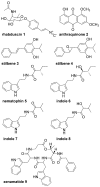Regulating alternative lifestyles in entomopathogenic bacteria
- PMID: 20022247
- PMCID: PMC2821981
- DOI: 10.1016/j.cub.2009.10.059
Regulating alternative lifestyles in entomopathogenic bacteria
Abstract
Bacteria belonging to the genera Photorhabdus and Xenorhabdus participate in a trilateral symbiosis in which they enable their nematode hosts to parasitize insect larvae. The bacteria switch from persisting peacefully in a nematode's digestive tract to a lifestyle in which pathways to produce insecticidal toxins, degrading enzymes to digest the insect for consumption, and antibiotics to ward off bacterial and fungal competitors are activated. This study addresses three questions: (1) What molecular signal triggers antibiotic production in the bacteria? (2) What small molecules are regulated by the signal? And (3), how do the bacteria recognize the signal? Differential metabolomic profiling in Photorhabdus luminescens TT01 and Xenorhabdus nematophila revealed that L-proline in the insect's hemolymph initiates a metabolic shift. Small molecules known to be crucial for virulence and antibiosis in addition to previously unknown metabolites are dramatically upregulated by L-proline, linking the recognition of host environment to bacterial metabolic regulation. To identify the L-proline-induced signaling pathway, we deleted the proline transporters putP and proU in P. luminescens TT01. Studies of these strains support a model in which acquisition of L-proline both regulates the metabolic shift and maintains the bacterial proton motive force that ultimately regulates the downstream bacterial pathways affecting virulence and antibiotic production.
Copyright 2010 Elsevier Ltd. All rights reserved.
Figures





Comment in
-
Host-pathogen interactions: proline gives insect pathogens the green light.Curr Biol. 2010 Jan 12;20(1):R13-5. doi: 10.1016/j.cub.2009.11.018. Curr Biol. 2010. PMID: 20152135
References
-
- Goodrich-Blair H, Clarke DJ. Mutualism and pathogenesis in Xenorhabdus and Photorhabdus: two roads to the same destination. Mol. Microbiol. 2007;64:260–268. - PubMed
-
- Waterfield NR, Ciche T, Clarke DJ. Photorhabdus and a host of hosts. Annu. Rev. Microbiol. 2009;63:557–574. - PubMed
-
- Bode HB. Entomopathogenic bacteria as a source of secondary metabolites. Curr. Opin. Chem. Biol. 2009;13:224–230. - PubMed
-
- Duchaud E, Rusniok C, Frangeul L, Buchrieser C, Givaudan A, Taourit S, Bocs S, Boursaux-Eude C, Chandler M, Charles JF, et al. The genome sequence of the entomopathogenic bacterium Photorhabdus luminescens. Nature Biotechnol. 2003;21:1307–1313. - PubMed
Publication types
MeSH terms
Substances
Grants and funding
LinkOut - more resources
Full Text Sources
Other Literature Sources
Molecular Biology Databases

